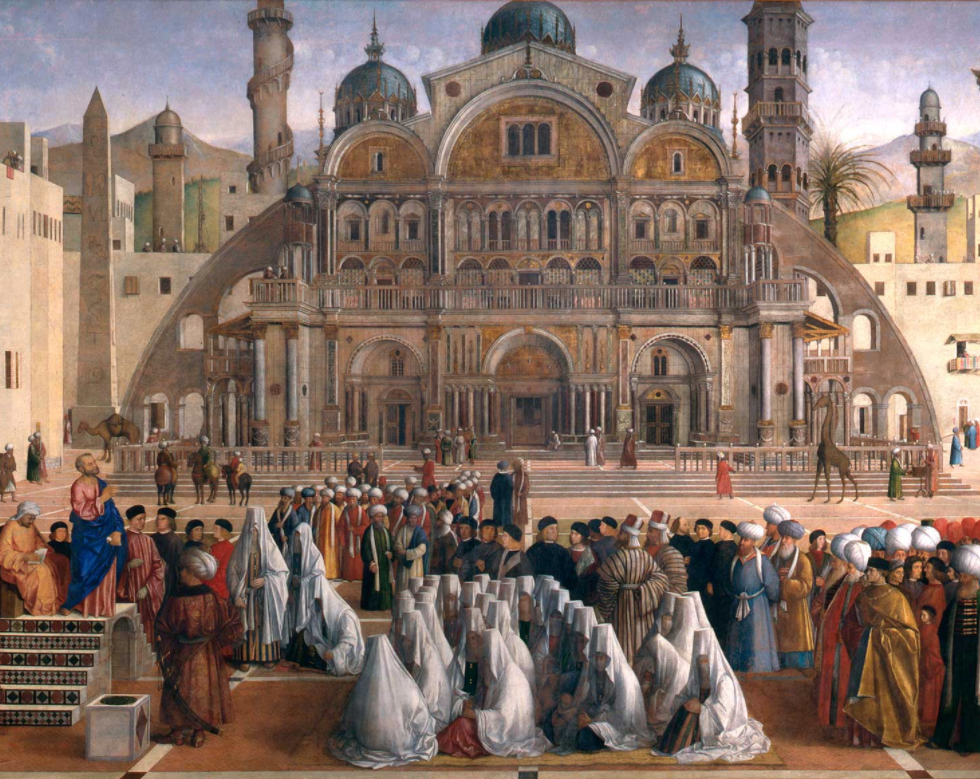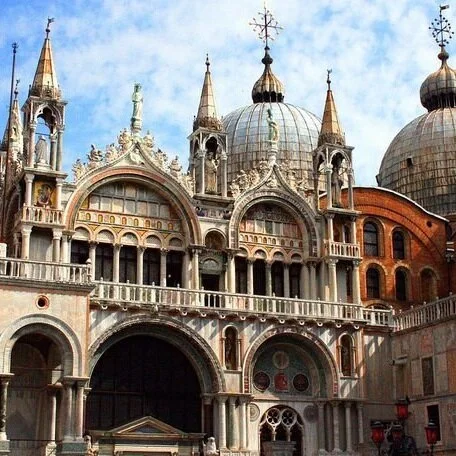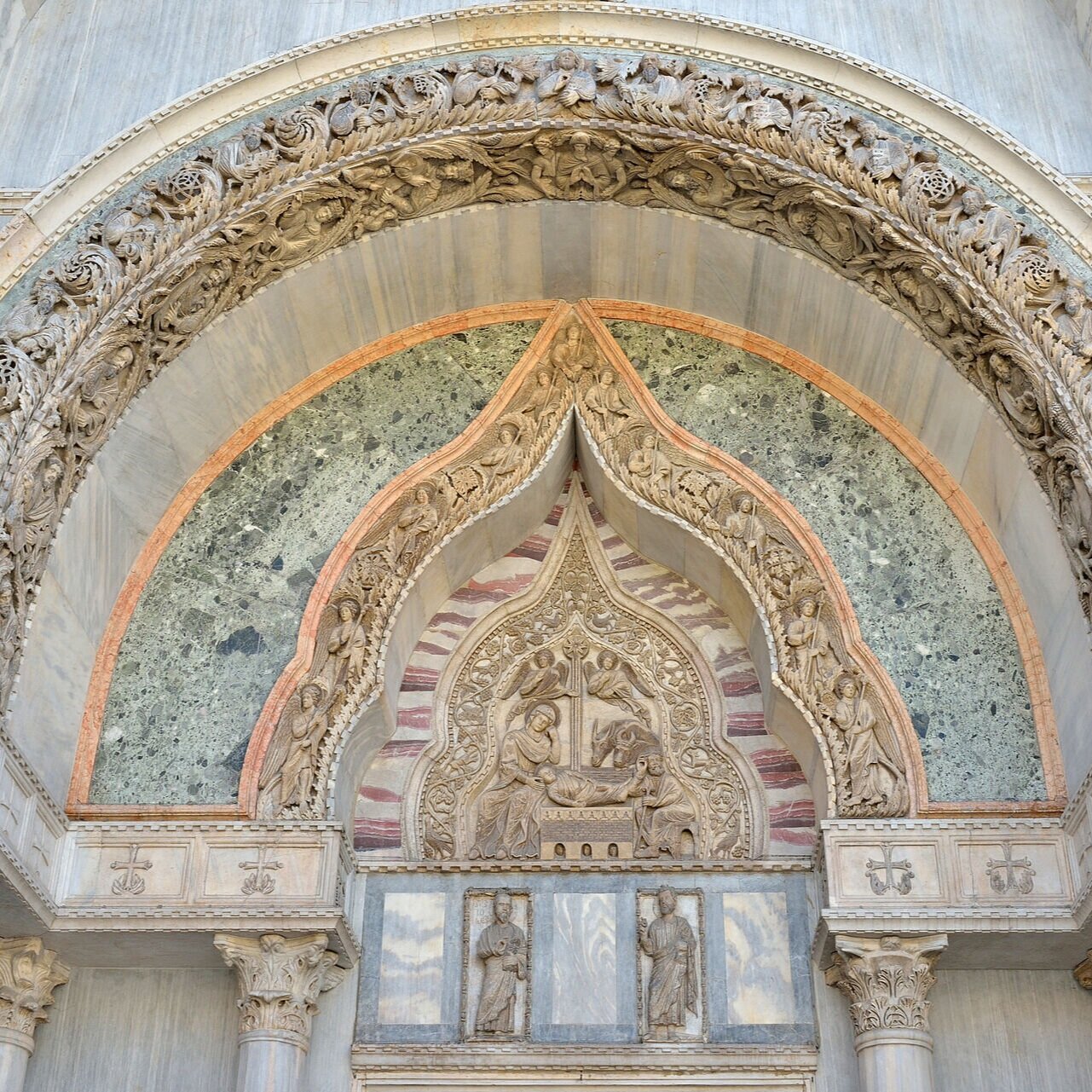J. W. Bunney, a former employee and disciple of John Ruskin, painted St. Mark’s in the late 19th century during 600 morning sittings.
“...beyond those troops of ordered arches there rises a vision out of the earth…a multitude of pillars and white domes, clustered into a long low pyramid of colored light; a treasure-heap, it seems, partly of gold, and partly of opal and mother-of-pearl, hollowed beneath into five great vaulted porches, ceiled with fair mosaic, and beset with sculpture of alabaster, clear as amber and delicate as ivory,—sculpture fantastic and involved, of palm leaves and lilies, and grapes and pomegranates, and birds clinging and fluttering among the branches, all twined together into an endless network of buds and plumes.”
“The first church of St. Mark’s was, doubtless, built in imitation of that destroyed at Alexandria, and from which the relics of the saint had been obtained.”
John Ruskin, The Stones of Venice
“St. Mark Preaching in Alexandria,” by Gentile and Giovanni Bellini, 1507. Their vision of the church in Alexandria is fictional, likely based on a visit to Constantinople. Contemporary scholars believe that St. Mark’s was patterned after the Church of the Holy Apostles in Constantinople which, like the church in Alexandria, no longer exists.
“This first church was however destroyed by fire, when the Ducal Palace was burned in the revolt against Candiano, in 976. It was partly rebuilt by his successor, Pietro Orseolo, on a larger scale; and, with the assistance of Byzantine architects, the fabric was carried on under successive Doges for nearly a hundred years; the main building being completed in 1071, but its incrustation with marble not till considerably later. It was consecrated on the 8th of October, 1085.”
A reconstruction of the original façade of St. Mark’s in the 11th century, before the domes were added (sometime after 1204).
Click on images to enlarge.
The mosaic over the left portal of St. Mark’s is a self-portrait done in the 13th Century.
The precious marble columns, carved screens, and sculpture were carted back to Venice after the sack of Constantinople in 1204.
The five domes (the fifth is behind the tall central dome) were added in the 12th C.
Floorplan of St. Mark’s showing placement of five domes.
Gentile Bellini, “Ducal procession in St. Mark’s Square,” 1496
BELOW, sections of the mosaic floors of St. Mark’s
The interior walls, vaults, and domes are covered with 90,000 square feet of mosaic tile, the preponderance of which are gold.
South façade of church, abutting the Doge’s Palace, clad in polychrome marble. Unadorned brickwork is visible on the right in front of the dome.
The “Pentecost” mosaic in the large central dome.
The main altar, with porphyry pulpit (right) as well as other rare polychrome marbles.
Detail, stone and marble work, north façade.
The “Creation” dome in the atrium
The crypt below main altar where St. Mark’s body, stolen by two Venetian merchants from Alexandria, is putatively buried.
The Quadriga, the four bronze horses looted from the Imperial hippodrome in Constantinople in 1204, stood outside above the central door of St. Mark’s until they were moved inside to prevent further deterioration.
The Pala D’oro, the golden altar screen, was first commissioned from Byzantine artisans by Doge Pietro Orseolo I in 976 and enlarged by Doge Ordelafo Falier in 1105. It is 9.8 ft wide, 6.6 ft tall and is made of gold. silver, enamel plaques, and 1,927 gems including 526 pearls, 330 garnets, 320 emeralds, 255 sapphires, 183 amethysts, 175 agates, 75 rubies, 34 topazes, 16 carnelians, and 13 jaspers.












